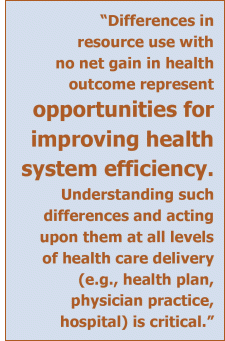An abstract is available at:
http://ajm.sagepub.com/cgi/content/abstract/23/5/365
Synopsis
This study of 31 commercial health plans, which examined the association between resource use, or cost, and quality of care for health plan enrollees with diabetes, found that quality and cost are largely unrelated. However, in this study higher pharmaceutical costs were significantly associated with higher-quality care.
The Issue
 How resource use, or cost, relates to health care outcomes is crucial for effective quality improvement efforts, but the connection is not well understood. As a result, health care payers see wide variations in outcomes and spending—with sometimes great variations from one region to another—even after accounting for differences in quality of care or population health. Resource use that does not improve quality-of-care outcomes may represent opportunities to improve health system efficiency.
How resource use, or cost, relates to health care outcomes is crucial for effective quality improvement efforts, but the connection is not well understood. As a result, health care payers see wide variations in outcomes and spending—with sometimes great variations from one region to another—even after accounting for differences in quality of care or population health. Resource use that does not improve quality-of-care outcomes may represent opportunities to improve health system efficiency.
Key Findings
- Total costs for diabetes care for all 31 health plans in the study were $1.6 billion; pharmacy services were the largest contributor to overall costs, accounting for about 40 percent.
- Resource use varied considerably more among organizations—as much as three to five times greater—than did quality-of-care results.
- Pharmacy costs showed the greatest amount of variation across health plans, even after adjusting for risk.
- Pharmacy costs had a statistically significant relationship with quality, indicating that health plans that spent more on pharmacy services for their members with diabetes had more favorable diabetes outcomes.
- No statistically significant associations were found between organizations' resource use and quality-of-care results for inpatient facility services, procedure and surgery, or evaluation and management.
- Results among health maintenance organizations (HMOs) varied less than among preferred provider organizations (PPOs), potentially due to the centrally managed nature of the HMO plans.
Addressing the Problem
Evaluating the broader impact of health plan interventions—including provider and consumer incentives, increased transparency with respect to costs and quality, and disease management programs—is possible only when resource use and health outcomes are measured and compared. Understanding why resource use varies, and how variation can be lessened without reducing quality, is an important area for future study.
About the Study
The sample included 31 commercial health plans (23 HMOs and eight PPOs), with enrollments ranging from fewer than 4,200 to more than 1.1 million members. Resource use was calculated using medical and pharmacy claims and enrollment data for adult members with diabetes in 2004 and 2005. Resource use was measured for a set of services that were clinically and financially important to diabetes care but also could be collected and standardized in a reliable way across plans. These included inpatient, pharmacy, evaluation and management, and procedural services. Quality-of-care results were calculated using indicators from the Healthcare Effectiveness Data and Information Set (HEDIS) diabetes measures.
The Bottom Line
Resource use may vary considerably without a commensurate increase in quality. Health plans may be able to favorably affect variation without sacrificing quality.


